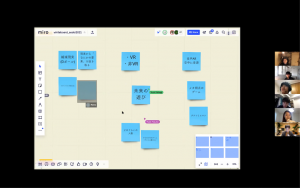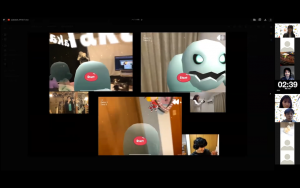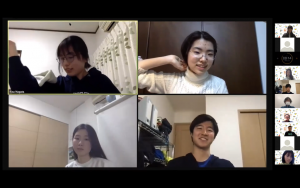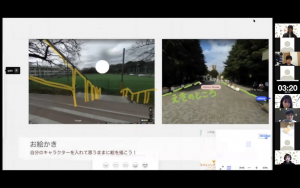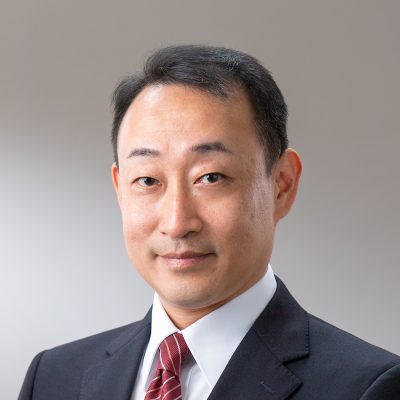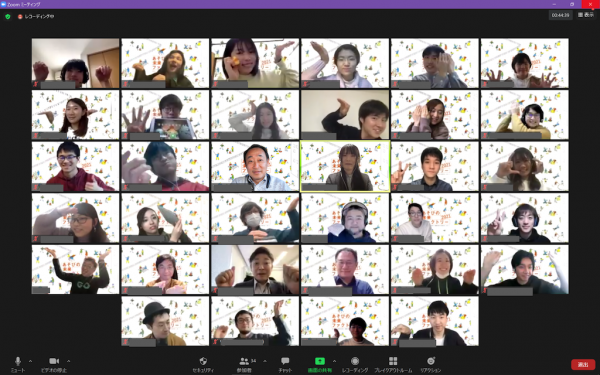
March 22, 2021
学生向けハッカソン「あそびの未来ファクトリー2021」Future Factory of ASOBI 2021: Students' Hackathon
2021年2月17日(水)から3月3日(水)にかけての2週間、第3回目となる東大生を対象にしたハッカソン「あそびの未来ファクトリー2021」を開催しました。このハッカソンでは参加者はチームを組み、「あそび」とはそもそも何なのかについて考えを深めることと、「未来のあそび」を考案することに取り組みました。今回は感染症対策のため全日程オンラインで実施しました。
2月17日は阪口特任研究員によって「あそび」そのものに関する考え方や定義、特にカイヨワによるあそびの類型についてレクチャーされ、2月19日は安斎特任助教によって「あそび」を創る際の考え方がワークショップ形式でレクチャーされました。
例年では参加者同士が対面で交流を深めながらチームを結成していましたが、今回はオンライン実施のため参加者にどんなあそびを作りたいかを事前アンケートで伺い、方向性が似ている人同士でチームが組まれるように運営側で設定しました。参加者たちは、チームごとにZoomのブレイクアウトルームに分かれ、Miroというオンラインホワイトボードを共同編集したりSlackでチャットやファイルのやりとりをしながら議論を行いました。
主に月曜日と金曜日に設けられた技術・デザインサポートdayでは、デザイナーやエンジニアとして活躍する方々をアドバイザーとして招き、Zoomのブレイクアウトルームを巡回する形で学生のアイデア出しや技術のサポートをしてもらいました。
中間発表会では、各チームからあそびの構想がプレゼンされ、学内外から招待された審査員やアドバイザーから質問やコメントを受けた他、参加者同士でもSlack上で質問やコメントを送り合いました。
最終成果発表会では、各チームが2週間かけて考案したあそびの紹介ビデオの上映とプレゼンが行われました。今回はオンラインでの実施であったため、どのチームもオンライン上で楽しめるあそびを考案していました。学生たちの意欲や積極性は例年に劣らず、どのチームも「あそび」について真剣に考え、独自の信念を持ってあそび創りに取り組んでいたことが、発表の様子から伺えました。制作過程で試行錯誤を重ねた結果の最終成果物はどれも見応えがありました。
全チームの発表が終わった後には、チームが考案したあそびを実際に体験したり意見交換するためのTouch & Tryの時間が設けられました。チームごとにブレイクアウトルームに分かれ、他のチームを見に行ったり、自分のチームのあそびを他のチームの人に体験してもらったりしました。
最終成果物に対しては審査が行われ、2つのチームが受賞しました。受賞チームの成果物はこちらのWebサイトで紹介しています。
受賞対象に限らず、どのチームにも面白い観点や将来性を感じるものがありました。オンラインの制約をあえて活用したり、オンラインでの不便さを乗り越えるために工夫をしたりと、自分たちのおかれている状況を前提としながら、柔軟にあそびを発想している様子が伺えました。あそびを形にする中で、あそびについて深く考えること、楽しさを言語化すること、アイデアを形に落とし込むことなどの様々な経験をし、各参加者の中でそれぞれの学びがあったことと思います。
あそびの未来ファクトリーでの活動をきっかけに、知り合った仲間と協働して、あそびをさらに発展させたり、何か新しいことを始めたりと、参加学生たちが今後も活躍していくことを期待します。
記事:阪口紗季(特任研究員)
A hackathon “Future Factory of ASOBI (play) 2021” for students at the University of Tokyo was held for two weeks from February 17 to March 3. In this hackathon, the participants formed teams and worked on creating prototypes of future play while thinking about what the concept of “play” itself means. The event was held online due to COVID-19.
On February 17, Project Researcher Saki Sakaguchi gave a lecture on the idea and definition of “play” itself, particularly Caillois’s classification of the four types of play. On February 19, Assistant Professor Yuki Anzai gave a lecture on methods for creating “play” in the form of a workshop.
In a usual year, participants would form teams while deepening exchanges face-to-face. This time, because the event was held online, the participants were asked what kind of play they would like to make, and teams were formed by participants with similar thinking. Participants were divided into Zoom breakout rooms for each team, and they discussed by co-editing an online whiteboard called Miro, while chatting and exchanging files on Slack.
On the technical and design support days, which were mainly held on Monday and Friday, we invited designers and engineers as advisers to hear student ideas and give technical support.
At the interim presentation, each team presented their concept of play, and questions and comments were given by jurors and advisers invited from companies and the university. Questions and comments were also exchanged among the participants on Slack.
At the final presentation, each team presented a promotion video and details of their ideas. This time it was done online, so every team devised a form of play that could be enjoyed online. Students were no less motivated and enthusiastic than in previous years. Every team thought seriously about the concept of “play” and engaged in the creation of new forms of “play” based on their own original convictions. The final products, which were the result of repeated trial and error during the prototyping, were all impressive.
After all teams had presented, Touch & Try was held to actually experience the play that the teams had created. Each team was divided into breakout rooms, and participants visited other teams and had people from other teams come to try out their own creations.
The final products were reviewed by jurors. As a result, two teams received awards. The winning teams’ products are introduced on this website.
Every team had unique and interesting points. Participants thought about play flexibly, presupposing their own situation while daring to take advantage of online restrictions and finding ways to overcome the inconvenience of the online environment. Each participant learned from the various experiences of the hackathon, such as thinking deeply about play, verbalizing their enjoyment, and putting their ideas into practice with a team.
We hope that the participants will continue to collaborate with the new acquaintances made at this hackathon to further develop their play and start new activities.
Text: Saki Sakaguchi(Project Researcher)
Proofreading: David Buist(Project Senior Specialist)
主担当教員Associated Faculty Members
教授
苗村 健
- 先端表現情報学コース
- 情報学環教育部
Professor
NAEMURA, Takeshi
- Emerging design and informatics course
- Undergraduate research student program


